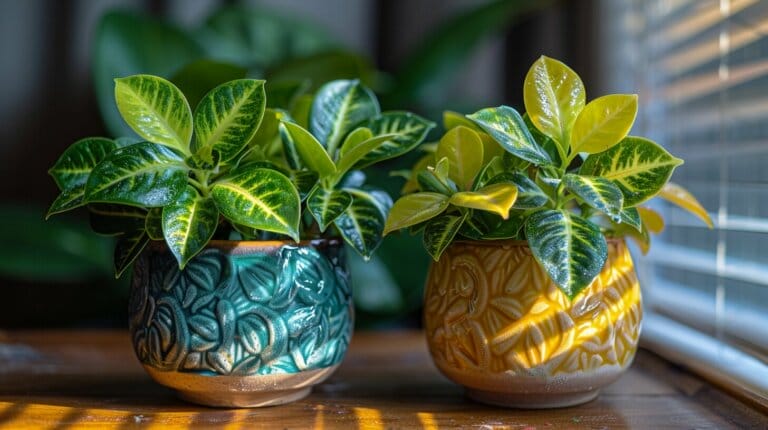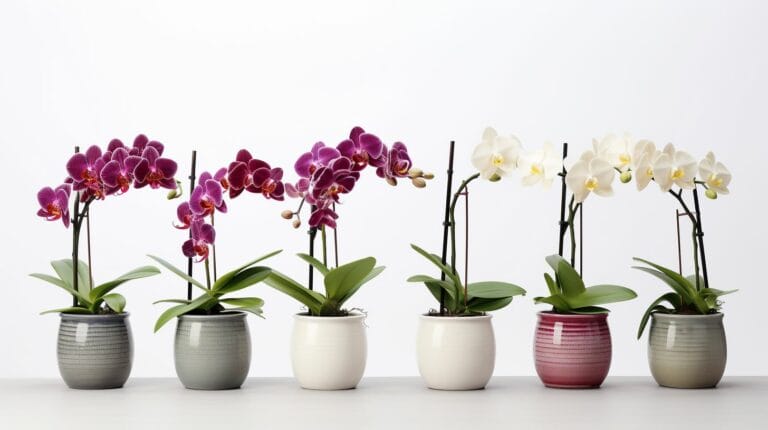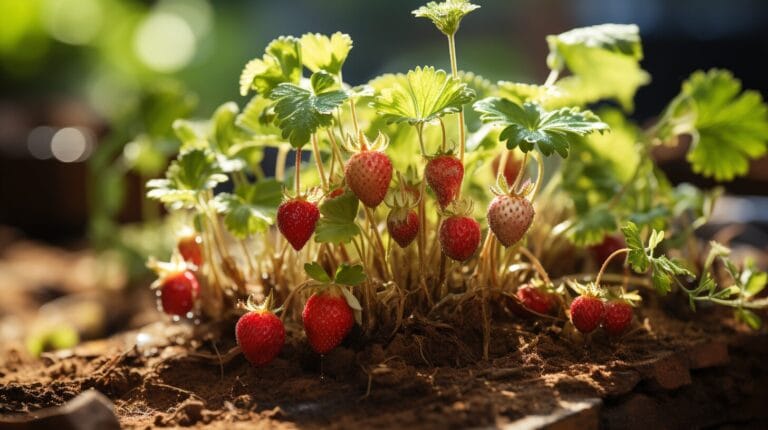Mother of Many Plants: Ultimate Care Guide for the Kalanchoe Daigremontiana in 2024
The soft glow of sunlight filters through the succulent leaves of your Kalanchoe Daigremontiana, creating a nuanced contrast of light and shadow that elegantly accentuates the small plantlets bordering its edges.
You’re about to learn how to care for this intriguing specimen, also known as the Mother of Many, whose unique reproductive strategy sets it apart in the plant world.
The steps are simple, yet they demand precision; too much water and the roots may rot, too little, and the leaves could wither.
You’ll want to grasp the nuances of its maintenance, for it’s not just about keeping the plant alive—it’s about understanding the delicate dance between nurturing and neglect that allows this succulent to thrive.
Stay with me, gardener, as we explore the subtleties of plant care, and prepare to grow Mother of Thousands that not only survives but also flourishes under your attentive eye.
Key Takeaways
- The Mother of Thousands, also known as Kalanchoe daigremontiana, is a succulent plant that reproduces by producing tiny plantlets on the edges of its leaves.
- It thrives in environments that mimic its native Madagascar habitat, requiring good drainage and bright, indirect light.
- Care for the Mother of Thousands includes providing bright, indirect light, watering thoroughly but allowing the soil to dry out between waterings, and using a well-draining potting mix.
- Propagation is easy with the plantlets that form on the leaf margins, and they can be placed on top of the soil to root and grow into new plants.
Introduction to the Mother of Thousands: The Mother of Many Plant

The Mother of Thousands, a unique member of the Crassulaceae family, is a succulent that captivates with its distinctive ability to reproduce through tiny plantlets that form on the edges of its leaves. Known scientifically as Kalanchoe daigremontiana, this plant is often called the Mother of Many Plants for its prolific propagation method.
These plantlets, similar to those of the Mexican hat plant, can drop off and root themselves with little to no gardener intervention, making the Mother of Thousands a prolific self-propagator.
As a succulent enthusiast or a beginner, you’ll appreciate that the Mother of Thousands, similar to bryophyllum plants, thrives in environments that mimic its native Madagascar habitat. Provide it with good drainage and place it where it can enjoy bright, indirect light indoors. Outdoors, it prefer a spot shielded from the harsh afternoon sun.
You’ll quickly notice the identifying features of this plant – the broad, fleshy leaves adorned with scores of tiny plantlets along their margins. These aren’t merely for show; they’re the future generations of the Kalanchoe daigremontiana, ready to take root and grow wherever they land.
You’re nurturing a living, self-propagating phenomenon by embracing the Mother of Thousands in your garden or indoor collection. Its ease of propagation means it can spread quickly, so managing its growth is key to ensuring it doesn’t overrun your space.
Complete Care Guide: Nurturing Your Mother of Thousands Plant

Having explored the unique propagation of the Mother of Thousands, let’s focus on nurturing your Kalanchoe daigremontiana. Optimal care hinges on understanding its specific needs, which are crucial for its health.
Lighting is key. Your plant, much like the way a jade plant grows, will thrive in bright, indirect light. Avoid too much direct sunlight, which can scorch the leaves, and too little light, which will stunt its growth. Indoors, a spot near a window with a sheer curtain is ideal. Outdoors, ensure it enjoys morning sun but is shaded during intense afternoon rays.
Watering requires a balanced approach. Just as with a jade plant, let the soil dry out between waterings for your Mother of Thousands to avoid root rot. When it’s time to water, do so thoroughly, ensuring your pot has adequate drainage.
Choose the right pot and soil. A terracotta or breathable material pot with a well-draining potting mix, like a cactus or succulent mix, will prevent water accumulation around the roots.
Propagating is easy. Those tiny plantlets will root when placed on top of the soil, growing into new plants.
Check your Mother of Thousands, just as you would with any garden plant, for signs of distress and adjust your plant care as needed. With these tips, your Mother of Thousands will not only survive but thrive.
Propagation: Multiplying Your Mother of Thousands

Embarking on the propagation journey with your Mother of Thousands is straightforward, thanks to the plantlets that form along the leaf edges. These are your ticket to propagation. Choose healthy plantlets and gently remove them, being cautious not to damage any delicate roots already formed.
Prepare a small pot with well-draining soil and place the plantlets on the surface. Keep the soil slightly moist and in bright, indirect sunlight. In a few weeks, the plantlets will take root. Once established, they can be repotted in a larger pot with good drainage.
Safety Considerations: Is the Mother of Thousands Poisonous?

While the Mother of Thousands is stunning, it contains toxic compounds that can be harmful if ingested. This is particularly important if you have pets or small children, similar to precautions taken when raising plantlets that grow on the edges of parent leaves.
The plant is poisonous, with all parts containing cardiac glycosides.
Symptoms of poisoning include vomiting, diarrhea, and heart rate changes. Seek immediate medical attention if ingestion occurs. Keep the plant out of reach and wash hands after handling. Have poison control or a veterinarian’s number ready in case of accidental ingestion.
Common Issues and Solutions in Caring for a Mother of Thousands

Common issues in plant care include improper watering and lighting, similar challenges seen when trying to grow Mother of Thousands. Yellowing leaves or a mushy stem suggest overwatering, while wrinkled leaves mean underwatering. Adjust your watering to when the top inch of soil is dry.
Light is also critical. Too little light causes leggy growth, while too much can scorch the leaves. Find a spot with bright, indirect light.
Repotting may be necessary if the plant outgrows its pot or the soil isn’t draining well. Use a well-draining potting mix and a container with drainage holes.
Pests like aphids, mealybugs, and spider mites can be managed with insecticidal soap or neem oil. Isolate the plant in severe cases.
The disease may present as spots on leaves or a sudden decline in health. Remove diseased parts and ensure good air circulation.
Conclusion
To keep your Mother of Thousands thriving, balance is key. Provide ample light, moderate watering, and the right soil mix. Propagate carefully and manage plantlets from the Mexican hat plant to prevent overgrowth. Remember the plant’s toxicity, a characteristic shared by the bryophyllum species, and keep pets and children safe.
With these tips, you’re all set to nurture the unique splendor of your Kalanchoe Daigremontiana.
Happy gardening!
Frequently Asked Questions
What exactly is a kalanchoe daigremontiana, also known as a mother of thousands?
The Kalanchoe daigremontiana, also known as the “mother of thousands” or “alligator plant,” is a type of succulent species. It’s a unique houseplant that is known for producing hundreds of baby plantlets along the edges of its leaves, hence the name. This plant is one of the few succulent types that can grow plantlets that give it its alternative names like ‘alligator plant’, ‘Mexican hat plant’, or ‘devil’s backbone’.
How do I take care of my mother-of-thousand plant?
Mother-of-thousand care involves giving the plant enough indirect light, around 6 hours of light per day is ideal. You should avoid exposing the plant to temperatures below 55 degrees. The plant prefers fast-draining potting soil – a mix of cactus soil and perlite works well. As for watering, it is advisable to water when the top inch of soil has dried out.
How should I water my mother of thousands?
Watering a mother of thousands succulents, much like watering a jade plant, should be done cautiously. Overwatering can lead to the rotting of the roots. It is advisable to water only when the top inch of the potting soil is dry, usually once a week. Being a succulent, it can tolerate drought conditions quite well.
How Can I Use Milk Jugs to Care for My Kalanchoe Daigremontiana Plant?
Repurpose your milk jugs to create sustainable gardening solutions with milk jugs for your Kalanchoe daigremontiana plant. Cut the jugs in half and use the bottom portion as a makeshift planter. This will help conserve water and keep your plant healthy while reducing your environmental impact.
Can the Care Guide for Kalanchoe Daigremontiana Help Prevent Yucca Plant Diseases?
The care guide for Kalanchoe Daigremontiana may not directly prevent Yucca plant diseases, but it can provide useful tips for maintaining plant health. However, a visual guide to Yucca plant diseases can help identify and address potential issues before they become serious threats to your plant’s well-being.
When should the mother-of-thousands plants start to flower?
The mother-of-thousands plants usually start to bloom in the late fall to early winter. They produce tall flower stalks, with blooms resembling the shape of a bell or a lantern. It is important to note that once a mother plant, such as the Mexican hat plant, flowers, it usually dies, but the plantlets ensure the growing cycle continues.
Why is it called the Mother of Thousands?
The plant gets its name from the fact that it produces a multitude of plantlets – tiny baby plants along the edges of its leaves. These baby plantlets grow attached to the main plant and eventually drop off and root in the surrounding potting soil, hence the name “Mother of Thousands.”







